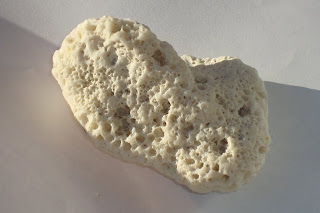
Serpentinite

Sphalerite

Pumice

Turquoise

Turquoise is an opaque, blue-to-green mineral that is a hydrous phosphate of copper and aluminium. As a secondary mineral, turquoise apparently forms by the action of percolating acidic aqueous solutions during the weathering and oxidation of pre-existing minerals. For example, the copper may come from primary copper sulfides such as chalcopyrite or from the secondary carbonates malachite or azurite; the aluminium may derive from feldspar; and the phosphorus from apatite.Turquoise was among the first gems to be mined, and while many historic sites have been depleted, some are still worked to this day.
Citrine

Citrine is a variety of quartz ranging in colors of yellow, yellow-brown, orange, dark orange-brown, reddish-brown. Most citrine comes from Brazil, but almost all of the Brazilian material is heat-treated amethyst. Natural citrine can also be found in the Ural Mountains of Russia, in Dauphine, France, and in Madagascar. Citrine is a 7.0 on the Mohs scale of hardness.
Amethyst

Amethyst is the purple variety of quartz and the most valued member of the quartz family. It must be purple to be amethyst, but it can display a range of shades including deep purple, light lilac, lavender and mauve. Amethyst on Mohs scale of hardness is 7.
Lapis Lazuli

Lapis Lazuli is considered a rock, not a mineral.Top quality Lapis Lazuli comes from Afghanistan where is has been mined for more than 6000 years, but is also found in Siberia, Chile, the U.S., Pakistan, and Canada. Strong blue, sometimes with a hint of violet, lapis lazuli's value decreases with the presence of white patches (calcite), while small veins of pyrite are often prized. A soft stone, 5 -5.5 on the Mohs scale of hardness, Lapis Lazuli is one of the most valuable semi opaque stones.
Petrified wood

Petrified wood is a type of fossil: it consists of fossil wood where all the organic materials have been replaced with minerals (most often a silicate, such as quartz), while retaining the original structure of the wood. The petrifaction process occurs underground, when wood becomes buried under sediment and is initially preserved due to a lack of oxygen. How long does it take wood to petrify? Probably less than 100 years.
Obsidian

Obsidian is a naturally occurring glass formed as an extrusive igneous rock. It is produced when felsic lava extruded from a volcano cools without crystal growth. Obsidian is commonly found within the margins of rhyolitic lava flows known as obsidian flows.
Sulfur

Sulfur is an abundant multivalent non-metal. Sulfur, in its native form, is a yellow crystalline solid. In nature, it can be found as the pure element and as sulfide and sulfate minerals. It is an essential element for life and is found in two amino acids, cysteine andmethionine. Its commercial uses are primarily in fertilizers, but it is also widely used in black gunpowder, matches, insecticides and fungicides.
Quartz

Golden beach sand and purple amethyst are both made of quartz. This mineral occurs in many rocks and is extremly common in the Earth's crust. Quartz crystals produce an electric charge if pressure is applied to them. This important property, known as piezoelectricity, gives quartz many uses and contributes to its value.
Hematite

Hematite is one of several iron oxides. Hematite is a mineral, colored black to steel or silver-gray, brown to reddish brown, or red. Hematite is harder than pure iron, but much more brittle.
Huge deposits of hematite are found in banded iron formations. Grey hematite is typically found in places where there has been standing water or mineral hot springs, such as those in Yellowstone National Park in the United States. The mineral can precipitate out of water and collect in layers at the bottom of a lake, spring, or other standing water.
Iceland Spar

Iceland spar, formerly known as Iceland crystal, is a transparent variety of calcite, or crystallized calcium carbonate, originally brought from Iceland, and used in demonstrating the polarization of light.It occurs in large readily cleavable crystals, easily divisible into rhombs, and is remarkable for its double refraction. .
Copper Ore

Malachite is a carbonate mineral normally known as "copper carbonate". This green-colored mineral crystallizes in the monoclinic crystal system, and most often forms botryoidal, fibrous, or stalagmitic masses. Individual crystals are rare but do occur as slender to acicular prisms.
Galena

Galena is the natural mineral form of lead sulfide. It is the most important lead ore mineral. Galena is one of the most abundant and widely distributed sulfide minerals. It crystallizes in the cubic crystal system often showing octahedral forms.
Onyx

Onyx is a cryptocrystalline form of quartz. The colors of its bands range from white to almost every color (save some shades, such as purple or blue). Commonly, specimens of onyx available contain bands of colors of white, tan, and brown. Sardonyx is a variant in which the colored bands are sard (shades of red) rather than black. Pure black onyx is common, and perhaps the most famous variety, but not as common as onyx with banded colors.
The name has sometimes been used, incorrectly, to label other banded lapidary materials, such as banded calcite found in Mexico, Pakistan, and other places, and often carved, polished and sold. This material is much softer than true onyx, and much more readily available. The majority of carved items sold as 'onyx' today are this carbonate material.
Chalcedony

Chalcedony is a cryptocrystalline form of silica, composed of very fine intergrowths of the minerals quartz and moganite. These are both silica minerals, but they differ in that quartz has a trigonalcrystal structure.
Chalcedony has a waxy lustre, and may be semitransparent or translucent. It can assume a wide range of colors, but those most commonly seen are white to gray, grayish-blue or a shade of brown ranging from pale to nearly black.
Pipestone

Pipestone is a type of argillite , usually brownish-red in color, which occurs in a matrix of Sioux quartzite. Numerous native american tribes used a variety of materials and catlinites for pipemaking for their sacred pipes. The red catlinite from the Pipestone quarries is the second softest rock in the world.
Pyrite

The mineral pyrite, or iron pyrite, is an iron sulfide. Pyrite is the most common of the sulfide minerals. The name pyrite is derived from the Greek (puritēs), “fire”. This name is likely due to the sparks that result when pyrite is struck against steel or flint. This property made pyrite popular for use in early firearms such as the wheellock.
Sandstone



Mention the word sand and many people will think of desert and beaches. They may also think of sandstone, a sedimentary rock that is made of grains of sand. Sandstone forms in a range of environments and is often used as a building stone.
Suscribirse a:
Entradas (Atom)
